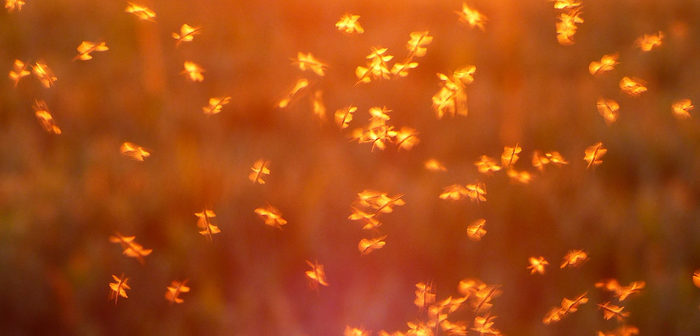Predicting the dispersal of airborne pests to protect crops demands an understanding of complex swarm dynamics that a simple mathematical model looks ready to tackle.
Midges move with ferocious randomness, frequently subjecting themselves to accelerations of more than 10g, well beyond the limit of fighter pilots, as they duck and dive in swarms that still retain an almost paradoxical cohesiveness despite blustery wind or powerful updrafts.
Collectively, midges move very differently from flocks of birds, shoals of fish or animal herds; there is no order to their flight, no orchestrated swoops or changes of direction. The movement of midges is completely haphazard, and can be astonishingly testing.
“Fortunately for midges, insect brains do not move around in the skull,” notes Andy Reynolds, a physicist at Rothamsted Research who studies insect flight for the institute’s Smart Crop Protection programme. His latest findings are published today in the Royal Society journal, Interface.
The aim is to predict, to “postcode-level” accuracy, where airborne pests, such as aphids, will turn up next. Aside from the complex flight dynamics, there is the problem that such behaviour has not been observed directly, through experimentation, so that prospective models could be honed.
“Instead, we have measurements of aerial density profiles and velocity statistics,” says Reynolds. He used this “simple” data, in an associated paper published last year, to formulate a theory on flight behaviour that collaborators from Stanford University were able to verify experimentally.
“We showed that you really can deduce insect flight behaviours from the simplest of observations,” says Reynolds. His latest research pushes the theory much further. He has devised a simple model that predicts the strange properties of midge swarms observed earlier.
“Midges frequently pull 10g or more; displace a swarm (with a gust of wind) and it behaves as a solid despite all that empty space; the swarm consists of a dense inner core and outer vapour phase with strange thermodynamic properties,” notes Reynolds.
“The theory may also explain why laboratory swarms and natural swarms behave differently – because of the impact of weather conditions,” he adds. “It seems remarkable that all this complexity can be deduced from the most basic of ingredients.”
The basis for his mathematical models is some “old school physics” in the form of the Langevin equation, which dates from 1908 and describes Brownian motion, the random movement of particles suspended in a fluid.
“Like other well established equations, there have been profound changes in our understanding of the contexts in which it is valid, and the reasons for its validity,” says Reynolds. “The midges are the latest example of such a shift in our understanding.”
He adds: “The equation shows that midge swarms are effectively bound together by gravitational-like forces and so are behaving a lot like clusters of stars.”
Reynolds is confident that mathematical models can capture airborne insect behaviour and forecast how pests will disperse. “Predicting the behaviours of single aphids is a whole lot easier than predicting the behaviour of a swarm; if we can do the latter so well, we can do the former despite the lack of data,” he says.




